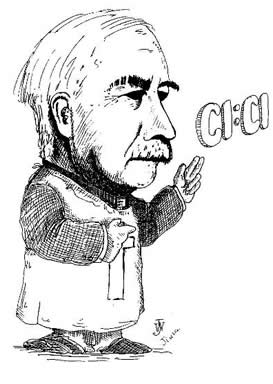
"The Pairing of Electrons"
October 1, 2007
Gilbert Newton Lewis (1876-1946) American chemist. Born in Weymouth, Massachusetts and raised in Lincoln, Nebraska, Lewis received his B.S., M.S. and Ph. D degrees from Harvard - the latter for work done on the electrochemistry of zinc and cadmium amalgams under the direction of Theodore Richards. Following postdoctoral study in Germany and three years as Superintendent of Weights and Measures for the Philippines, Lewis was appointed Professor of Chemistry at MIT (1905). In 1912 he was appointed Professor and permanent Dean of the College of Chemistry at the University of California-Berkeley, a position which he held until his death in 1946. In the field of chemical bonding he is best remembered today for his introduction of the shared electron-pair model of the covalent bond (1916), his electron dot diagrams, and his electron-pair donor-acceptor definitions of acids and bases (1923). He and his associates are also responsible for much of the quantification of 20th-century thermodynamics and for the introduction of such concepts as fugacity (1901), activity (1907) and ionic strength (1921). In addition, Lewis also did important work on the chemistry of deuterium (1933-1934) and on the nature of phosphorescence and the triplet state (1936-1946).
Courtesy of Professor William Jensen, Oesper Chair of the History of Chemistry and Chemical Education, University of Cincinnati
> Past Notable Chemists